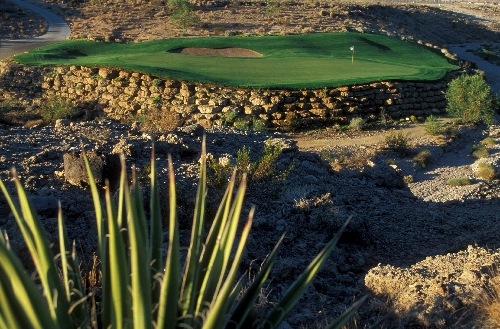TPC Las Vegas tests players’ mettle

Southern Nevada boasts an abundance of well-designed, beautifully maintained resort courses geared toward the typical recreational golfer — who, contrary to anecdotal evidence gathered at the 19th hole — shoots in the neighborhood of 100 during a round. TPC Las Vegas is not exactly one of those courses.
This observation isn’t intended as a criticism. After all, the course designer took considerable measures to accommodate players of varying skill levels, including the use of a “blended” set of tees for players who don’t find the white resort tees quite long enough but are a little overmatched from the blues.
Conditions at TPC Las Vegas are predictably immaculate, and the facility exudes a level of refined professionalism that is unsurpassed in the valley. The cautionary note is only warranted because too many players base their performance expectations on the listed yardage; on this course, distance is the least of one’s concerns.
Case in point is the opening hole, a short par 4 that plays only 359 yards from the tips. For longer hitters, the bunker jutting in from the left is in play, but laying back to a comfortable wedge distance is advisable anyway. Any shots that land on the front or left sides of the putting surface will almost certainly roll off the edge, so precision with the short approach is mandatory. Most players are content to escape with a two-putt par, only to discover that this is TPC Las Vegas’ second easiest hole.
This gentle opener is followed by arguably the single most intimidating shot on the course. This 196-yard par 3 features an island green amid a sea of stone, demanding a fully committed swing. There is a small bailout zone to the right, while the greenside bunker beckons like a life raft. With some of the most consistent, firm sand players will ever blast from, it’s easy to understand how tour pros have such great control from the beach.
At 604 yards, the par-5 sixth hole is the longest offering on the front side. A legitimate three-shot hole for most players, the key to success is avoiding the numerous bunkers and thick, juicy rough. Taking less club from the tee is prudent for those whose drivers tend to stray in either direction, because the only safe spot is in the middle of the fairway. The second shot must carry or skirt a trap that juts in from the right, with the ideal finishing position being along the fairway’s left side to minimize the influence of the front greenside bunker. Players should beware of a forward pin placement, because any approach near the green’s front edge will likely trickle back down into the throat.
The outward road ends as it began, with a short par 4 that is far more difficult than it appears. The desert fronting the tee boxes requires more carry than one would think, and only prodigious drivers should try to carry the wide bunker that barricades the fairway’s entire left side. Those who take the more conservative route to the right are “rewarded” with a semiblind approach to a shallow, well-fortified green.
The back nine opens with two long par 4s that demand respect. Following a 419-yard offering to begin the trek comes a 444-yard beast. Reaching this green requires two solid shots, with a drive skirting the left fairway bunker representing the ideal line. The putting surface is defended by a solitary bunker along the right, making the long, run-up approach a more feasible proposition.
Although players are buoyed by the prospect of a 365-yard par 4 at No. 14 — the only par 4 on the back nine that is not well over 400 yards — the enthusiasm quickly fades when they reach the tee box and can’t find the hole. Unless one has the good fortune to play with one of TPC Las Vegas’ affable members, this hole in itself justifies the purchase of a yardage book.
The target from the tee should be the distant steeple; on that line, the desert bordering the fairway’s right edge is not a factor, and the intimidating approach is merely nerve-rattling. While clubbing down might seem prudent given the blind tee shot, adding distance to a second shot that must carry a green-fronting ravine is an unwise strategy.
TPC Las Vegas ends with, surprise, a very tough par 4 measuring 448 yards from the back and an impressive 421 yards even from the combination tees. A pair of bunkers brackets the fairway, but the left one is out of reach for most players. Even from the short grass, however, the second shot is daunting, with water coming into play at about 100 yards out and continuing to the slender green’s left edge. A bevy of bunkers borders the putting surface, providing little margin for error. To avoid a big number, players with more accomplished short games should at least consider intentionally missing short to take the water and bunkers out of play, then scrambling for the up-and-down save.
TPC Las Vegas is one of the few courses in Southern Nevada where players can score five strokes over their average and still leave feeling good about the round. While this is anything but a walk in the park, it does provide both an excellent challenge and an accurate barometer for the state of one’s game.
TPC Las Vegas is located at 9851 Canyon Run Drive in the heart of Summerlin. For information or to reserve a tee time, call 256-2000 or visit www.tpc.com/lasvegas.












